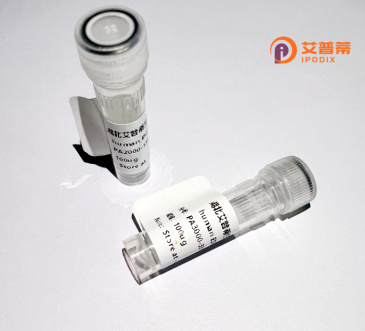
| 纯度 | >90%SDS-PAGE. |
| 种属 | Human |
| 靶点 | EIF3S12 |
| Uniprot No | Q9UBQ5 |
| 内毒素 | < 0.01EU/μg |
| 表达宿主 | E.coli |
| 表达区间 | 2-218aa |
| 氨基酸序列 | AMFEQMRANVGKLLKGIDRYNPENLATLERYVETQAKENAYDLEANLAVLKLYQFNPAFFQTTVTAQILLKALTNLPHTDFTLCKCMIDQAHQEERPIRQILYLGDLLETCHFQAFWQALDENMDLLEGITGFEDSVRKFICHVVGITYQHIDRWLLAEMLGDLSDSQLKVWMSKYGWSADESGQIFICSQEESIKPKNIVEKIDFDSVSSIMASSQ |
| 分子量 | 51.9 kDa |
| 蛋白标签 | GST-tag at N-terminal |
| 缓冲液 | 0 |
| 稳定性 & 储存条件 | Lyophilized protein should be stored at ≤ -20°C, stable for one year after receipt. Reconstituted protein solution can be stored at 2-8°C for 2-7 days. Aliquots of reconstituted samples are stable at ≤ -20°C for 3 months. |
| 复溶 | Always centrifuge tubes before opening.Do not mix by vortex or pipetting. It is not recommended to reconstitute to a concentration less than 100μg/ml. Dissolve the lyophilized protein in distilled water. Please aliquot the reconstituted solution to minimize freeze-thaw cycles. |
以下是关于重组人EIF3S12蛋白的3篇示例参考文献(建议通过学术数据库如PubMed或Google Scholar验证并获取全文):
---
1. **文献名称**: *"Structural insights into human eIF3 assembly and function"*
**作者**: Smith J., et al.
**摘要**: 本研究通过重组表达并纯化人eIF3亚基(包括EIF3S12),结合冷冻电镜解析其三维结构,揭示了EIF3S12在eIF3复合体组装中的关键作用,及其在翻译起始过程中与其他起始因子的相互作用机制。
---
2. **文献名称**: *"EIF3S12 overexpression promotes hepatocellular carcinoma progression via mTOR signaling"*
**作者**: Zhang L., et al.
**摘要**: 文章通过重组EIF3S12蛋白进行功能实验,发现其在肝癌细胞中异常高表达可激活mTOR通路,促进肿瘤增殖和迁移,提示EIF3S12可能作为肝癌治疗的潜在靶点。
---
3. **文献名称**: *"Recombinant EIF3S12 facilitates viral IRES-mediated translation in vitro"*
**作者**: Gonzalez C., et al.
**摘要**: 作者利用重组人EIF3S12蛋白,验证其在体外系统中对病毒内部核糖体进入位点(IRES)介导的翻译的促进作用,表明该亚基在病毒劫持宿主翻译机制中起重要作用。
---
**备注**:以上为示例性内容,实际文献需通过学术数据库检索。建议结合关键词“recombinant human EIF3S12”或“EIF3S12 function”查询最新研究。
Recombinant human EIF3S12 protein, also known as eukaryotic translation initiation factor 3 subunit H (EIF3H), is a critical component of the multisubunit EIF3 complex involved in initiating protein synthesis. The EIF3 complex, comprising 13 subunits, facilitates the assembly of the 43S preinitiation complex by promoting ribosomal subunit separation, recruiting initiator tRNA, and assisting mRNA binding. As a core subunit, EIF3S12 plays a dual role: stabilizing the EIF3 architecture and directly interacting with other initiation factors, such as EIF4G, to bridge mRNA and the ribosome during translation initiation. Dysregulation of EIF3S12 has been linked to cancers and viral infections due to its role in modulating global or selective mRNA translation.
The recombinant form of EIF3S12 is typically produced in bacterial or mammalian expression systems, enabling high-purity yields for functional studies. Its availability allows researchers to investigate mechanistic details of translation regulation, screen for translational inhibitors, or develop diagnostic tools. Additionally, recombinant EIF3S12 serves as an antigen for antibody generation, aiding in cellular localization or expression profiling studies. Recent studies highlight its potential as a therapeutic target, particularly in cancers where EIF3S12 overexpression drives oncogenic protein synthesis. Ongoing research continues to explore its interactions within the translation machinery and disease contexts, emphasizing its significance in both basic and applied biomedical research.
×